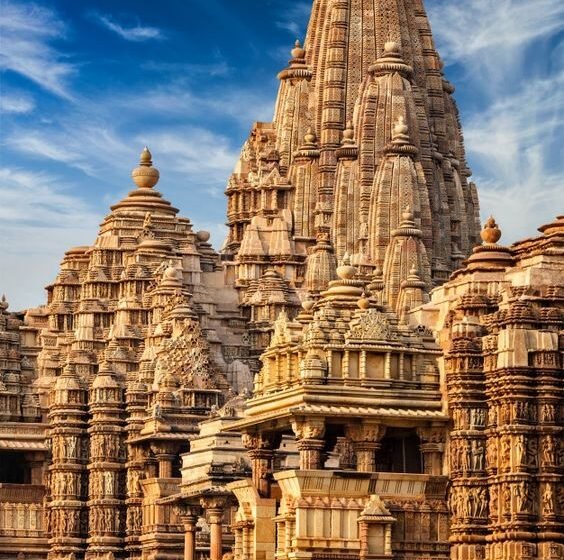Indian Temple architecture – crafting the house of worship

Indian Temple architecture – crafting the house of worship
“God is in the details.”
– Ludwig Mies van der Rohe
The Latin term templum denotes a sacred enclosure from which the word “temple” is derived. The definition of a temple states that it is a building set aside for spiritual or religious rituals like sacrifice and prayer. The temple is traditionally seen as a holy building and a representation of God’s habitation.
As we all know, temples play a significant role in the people’s cultural, social, and economic life in addition to serving as places of worship. Temple construction was the most important of all early Indian construction. This religious action was an exhibition of wealth, energy, talent, education, and the art of the land.
A circle of stones where people once housed sacred objects is thought to be the true ancestor of Hindu temples. Religious building had been practiced since the Vedic era (1500–500 B.C.) but with easily deteriorated materials.
The earliest shrines were located in caves and the earliest notable stone buildings in India were built under the direction of the monarch Ashoka. They were rock-cut temples known as stupas or Chaityas. A temple’s structure is known to have derived from a Vedic stupa.

The Nagara or Northern style, Dravida or Southern style, and Vesara or the mixed style, are the three principal types of temple architecture in India. However, there are also certain regional forms such as Badami Chalukya, Maru Gurjara, Gadag and Kalinga.
The “Sikhara” (spire) continued to be the most noticeable element of north Indian temples, whereas the entryway was typically understated. The “Gopurams” (huge gateway towers) and the enclosures surrounding the temples were the two most noticeable characteristics of South Indian temples. The devotees were guided into the holy courtyard by the Gopurams. The Northern and Southern styles shared a lot of characteristics. These included the layout of the building, the placement of the stone-carved deities both inside and outside, and the variety of decorative features.

The two-part sanctuary is known as the “Vimana” as a complete. The “Sikhara” refers to the top of the Vimana. The garbha-griha, meaning the womb chamber, is the lower section inside the vimana. It plays a significant role in Indian temples. There is an orbiting passage around the garbha-griha called “Pradakshina patha”. The pillared hall in front of the garbhagriha is called the “Mandapa,” and the “Ardhamandapa” is the temple’s main entrance that leads to the mandapa. “Antarala” refers to the middle chamber, and “Gopurams” refer to the ornate towers at the temple’s entrance. The platform of the temple is known as “Pitha,” and its traditional entryway, known as “Toranas,” is most often found in temples in northern India. The “Amalaka” is a fluted disc-like stone placed at the top of the sikhara.
According to Indian philosophy, the pursuit of artha– riches and success, kama– sexual pleasure, dharma– moral life and values, and moksha– self-knowledge and realization are the four fundamental and significant concepts and the goals of human life.
Such concepts are illustrated and revered in geometrically organized areas, elaborate artwork, adorned and carved pillars, and statues of Hindu temples. The Purusha (which refers to the Universal principle of spirit, person, self, or consciousness that is omnipresent and associated with all things without any form) is symbolized by a hollow space devoid of any decorations in the center of the temple, usually beneath the deity. The process of self-realization is prompted by the Hindu temples, which encourage contemplation, further mental purification, and devotion.

Under Ashoka the Great’s administration, India experienced significant advancements in architecture. By ordering stupas and shrines, he promoted Buddhist architecture, and the Ashokan Period’s masonry was incredibly diverse.
The Pallava, Chola, and Vijayanagara courts’ architects deserve praise in addition to their monarchs. Temples like the Meenakshi and the rock-cut temples at Thanjavur and Mahabalipuram are evidence of the South Indian kings’ superior construction skills.

Most architectural treatises provide a mythical genealogy of the painters. The four heavenly architects Visvakarman, Maya, Tvashtar, and Manu are said to have descended from the four faces of Brahma, the creator. The names of their sons are Sthapati, Sutra-grahin, Vardhaki, and Takshaka, respectively. These four are the forerunners of the four classes of terrestrial artists. A guild of architects is made up of the head architect or master builder, the designer or draughtsman, the painter, and the joiner, each of whom is an expert in their respective field.
The Rajput architectural style is a later regional style introduced in India. The Golden Temple was the finest example of Sikh architecture that is seen in Amritsar. In the 17th to 19th centuries, Maratha architecture was
widely popular. At this time, India’s architectural design evolved into a more contemporary look.
India’s temples now are a popular destination for tourists. This nation is a spiritual hub for visitors thanks to its magnificent temples dating back centuries. It also has a strong cultural heritage and a long history of kingdoms.
In India, there are more than 60,000 temples. Ancient Greek and Egyptian temples, Shiva temples, and some of the oldest and richest temples in the world may all be found here. Some of the Hindu, Jain, and Buddhist shrines are considered marvels of religious construction.

So, it is fascinating to think about the historical architectural processes that resulted in the creation of India’s stunning temples. Not only do they serve as houses of worship, but they are also a source of beautiful architectural wonders. The visual splendor, religious significance, cultural significance, and many other factors make these temples famous tourist sites.
The urge to maintain memories of past lives has increased significantly given how quickly the world changes. For this preservation, the option of restoring buildings rather than replacing them is increased by architectural heritage conservation.
Heritage conservation is restoring, conserving, and controlling changes in a heritage site in a way that sustains and enhances its relevance. Retaining a structure’s historical context, conventional building methods, materials, style, and any other characteristic that relates to its intended use is a significant goal of conservation and restoration.
The existence of temples in this world is both a great blessing and a great duty. We must take care of them energetically, which includes cleaning them frequently and fixing any damage to the buildings and sacred images and sculptures inside. We also need to have some understanding of how they affect the world spiritually. Through this work, we can gain the blessings of the Saints and the countless Devas in the revered temples.
Vihang Ghalsasi during his travels across the nation has produced a list of the top ten temples that he found most appealing. They are organized from north to south according to their geographic location.
Kedarnath Temple, Uttarakhand
The Mahabodhi Temple, Bihar
Kandariya Mahadev Temple, Madhya Pradesh
Modhera Sun Temple, Gujarat
Dilwara Temples, Rajasthan
Kailash Temple, Maharashtra
Konark Sun Temple, Odisha
Vitthala Temple, Karnataka
Hoysaleshwar Temple, Karnataka
Brihadisvara Temple, Tamilnadu


